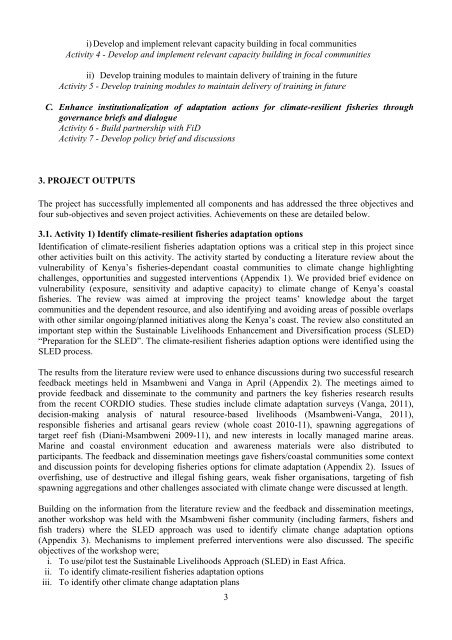CORDIO-FAO-climate-change-Project-FINAL-REPORT-29th-November-2012.pdf
CORDIO-FAO-climate-change-Project-FINAL-REPORT-29th-November-2012.pdf
CORDIO-FAO-climate-change-Project-FINAL-REPORT-29th-November-2012.pdf
Create successful ePaper yourself
Turn your PDF publications into a flip-book with our unique Google optimized e-Paper software.
i) Develop and implement relevant capacity building in focal communitiesActivity 4 - Develop and implement relevant capacity building in focal communitiesii) Develop training modules to maintain delivery of training in the futureActivity 5 - Develop training modules to maintain delivery of training in futureC. Enhance institutionalization of adaptation actions for <strong>climate</strong>-resilient fisheries throughgovernance briefs and dialogueActivity 6 - Build partnership with FiDActivity 7 - Develop policy brief and discussions3. PROJECT OUTPUTSThe project has successfully implemented all components and has addressed the three objectives andfour sub-objectives and seven project activities. Achievements on these are detailed below.3.1. Activity 1) Identify <strong>climate</strong>-resilient fisheries adaptation optionsIdentification of <strong>climate</strong>-resilient fisheries adaptation options was a critical step in this project sinceother activities built on this activity. The activity started by conducting a literature review about thevulnerability of Kenya’s fisheries-dependant coastal communities to <strong>climate</strong> <strong>change</strong> highlightingchallenges, opportunities and suggested interventions (Appendix 1). We provided brief evidence onvulnerability (exposure, sensitivity and adaptive capacity) to <strong>climate</strong> <strong>change</strong> of Kenya’s coastalfisheries. The review was aimed at improving the project teams’ knowledge about the targetcommunities and the dependent resource, and also identifying and avoiding areas of possible overlapswith other similar ongoing/planned initiatives along the Kenya’s coast. The review also constituted animportant step within the Sustainable Livelihoods Enhancement and Diversification process (SLED)“Preparation for the SLED”. The <strong>climate</strong>-resilient fisheries adaption options were identified using theSLED process.The results from the literature review were used to enhance discussions during two successful researchfeedback meetings held in Msambweni and Vanga in April (Appendix 2). The meetings aimed toprovide feedback and disseminate to the community and partners the key fisheries research resultsfrom the recent <strong>CORDIO</strong> studies. These studies include <strong>climate</strong> adaptation surveys (Vanga, 2011),decision-making analysis of natural resource-based livelihoods (Msambweni-Vanga, 2011),responsible fisheries and artisanal gears review (whole coast 2010-11), spawning aggregations oftarget reef fish (Diani-Msambweni 2009-11), and new interests in locally managed marine areas.Marine and coastal environment education and awareness materials were also distributed toparticipants. The feedback and dissemination meetings gave fishers/coastal communities some contextand discussion points for developing fisheries options for <strong>climate</strong> adaptation (Appendix 2). Issues ofoverfishing, use of destructive and illegal fishing gears, weak fisher organisations, targeting of fishspawning aggregations and other challenges associated with <strong>climate</strong> <strong>change</strong> were discussed at length.Building on the information from the literature review and the feedback and dissemination meetings,another workshop was held with the Msambweni fisher community (including farmers, fishers andfish traders) where the SLED approach was used to identify <strong>climate</strong> <strong>change</strong> adaptation options(Appendix 3). Mechanisms to implement preferred interventions were also discussed. The specificobjectives of the workshop were;i. To use/pilot test the Sustainable Livelihoods Approach (SLED) in East Africa.ii. To identify <strong>climate</strong>-resilient fisheries adaptation optionsiii. To identify other <strong>climate</strong> <strong>change</strong> adaptation plans3


















